Woody's Electric 240SX · 16 December 05
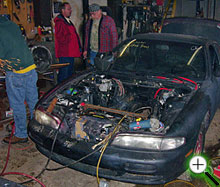
We’ll title this,
“Woody’s EV undergoes open heart surgery. Diagnosis looks promising…”
Woody Becher is converting a 1995 Nissan 240SX. I got an email from him a couple months ago when he was trying to use our battery layout tool and wondered how to rotate the batteries. Come to think of it I still haven’t fixed that problem.
For the short term simply lay your monitor on its side…
I’m not sure how long Woody’s been working on the EV or which one of the fellows in the photo is him. Here’s the plan for his electric car conversion:
- Advanced DC Motor 203-06-4004 (excess Corbin Sparrow motor from EV America
- 15 Trojan T-875 8vdc batteries (120v pack)
- Curtis 1221C-7401 Controller
For the rest of the story let’s turn the typewriter over to Woody…
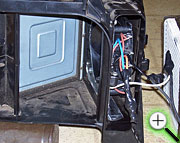
This shows my electric heater core installed in the heater box.
The old heater core is beside it for reference. I installed it in the car and plugged it into 120VAC to test, and it puts out heat and didn’t melt the box or start on fire so I think it will be OK. Just a little scary having that kind of heat that close to the plastic heater box. You can see it installed in dash picture (at bottom of page), it is the only thing in the car besides the steering wheel and passenger side air-bag.
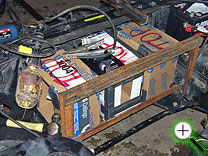
This shows the beginnings to a front battery frame. The cardboard batteries were a great idea. Thanks!
I downloaded the electrical drawings from AHDOL.com. They have any car’s electrical diagrams for 12 dollars or specific sheets for about half that. I paid the 12 dollars and got a PDF of the entire electrical system (40 pages.) It’s come in handy several times already.
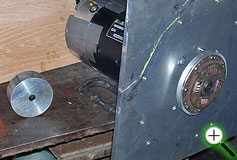
Here’s the motor attached to the adapter plate (before I cut the final shape.) Notice the new alignment tool to the left of the motor. The I.D. is the same as the diameter of the transmission input pilot shaft instead of the motor coupling. This directly aligned the center of the hole in the adapter plate with the transmission shaft, eliminating any slop in the clutch plate/coupling assembly. Then instead of just drilling the bolt hole pattern, we drilled two small holes through the plate into the bell housing. Then we inserted spring pins to firm up the alignment. That way when you remove the plate the alignment pins will bring you exactly back to within a few thousandths.
The clearance holes for the bolt hole pattern typically are at least 1/64” oversized to allow the bolts to easily slide through. This movement will translate to the plate when you bolt it in place. I am a chemical engineer and have worked around rotating equipment for some time. We typically would align a 4000RPM motor to much tighter tolerance. Otherwise we tend to see excessive vibration (which you can’t always detect without vibration equipment) that will shorten the life of your motor output bearings and your input seal on the transmission. Of course we run things 24/7, so we see a lot more run hours in a shorter time. You may go thousands of mile with no issue. The spring pins are cheap and the installation only takes a few minutes. Next update I’ll send you pictures of the pins if you would like. [Sure! -JH]
I tried using a saws-all on this plate and experienced your Wile E Coyote earthquake pill syndrome, so I stopped. I was able to use a plasma cutter at work on the adapter plate. This worked very well (<5min.) and produced an OK edge (had to grind a little to smooth out the burrs.) I’d recommend it if you can get your hands on one.
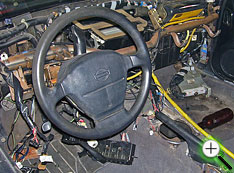
Thanks Woody. A plasma cutter? That sounds like a great xmas stocking stuffer. ”:^)
Here’s a view of his 240SX dash. I’d like to go on record as saying that I hadn’t even considered using a beer bottle while working on the dash, although I can certainly see how it might help!
The scary thing is that it I’m getting a sense of Déjà Vu looking at all of the exposed wiring. And look at the size of that steel pipe running across the front.
Thanks for the pictures and EV update, Woody. Always great to see another conversion and hear how other folks undertake their own project.
If you have an EV project that you’d like to share, feel free to contact me.


Good luck Woody! I’m test driving my EV tonight about 18 miles. Using a 96V pack of Trojan 6Vs and I’ll tell everybody how they run when everything is bedded in.
I’m not brave enough to convert my own yet! Took the easy option of buying someone else old conversion. Having not seen my adapter plate go on, I do worry a little how well it is aligned, the roll pins are a good idea!
Any news on the status of this conversion. I have my 95 240sx outside that I recently cracked the engine in. Considering converting it to electric so wanted to get any info on how this one turned out before i rip mine apart.
I’ve been driving my conversion for almost exactly a year now. It works fairly well. My major complaint is that it is a little doggy and the range is a little less than I planned (especially on really cold days) So I will be troubleshooting this this summer. I think the posi-track rear end plays a part. I’m going to switch to red-line oil to try and reduce drag. Also mine sat in a junk yard for several years so I probably need to check the bearings, breaks etc for unnecessary drag. I also had not added the DC/DC convertor to power the 12V system (I’m cheep and chocked on the $460 price.) So I had to charge it separatly every night. However, last week Bob Batson turned me on to a cheeper convertor which has been working well so far.
I am using the Red Line Superlight in my manual transmission. its a bit notchy on the gearchange, otherwise OK.
I had high hopes that our first EV would somehow get much higher range than folks/books predicted, but batteries being batteries it didn’t.
A common mistake is to calculate range for 100% DOD (depth of discharge), which is something you wouldn’t normally be doing; especially in the winter. Cold weather typically means 30% less range, at least for lead acid batteries.
The best way to calculate range is using 50-75% DOD. Then, when you get that estimate, subtract a third to see what cold weather range will be like. Be brutally honest with range and picking batteries, then if it happens to come out with slightly better range you’ll be happy!
Also, as you point out, anything else that is harder to turn or move in the winter will cause less range (or less MPG if you are driving a gas car).
As I live in TX, it doesn’t get severely cold here. The lowest it will get is maybe mid-30’s. I’m hoping by now that there are newer/better components to purchase. Are you still using the 5-spd tranny in the 240?
Yes, still using the manual 5spd. Use 1st up to 20-24mph, 2nd up to 40-45, and 3rd for highway speeds. I am seriously considering replacing the posi-track rear end with a much lower geared regular rear end. A note to anyone considering using the Astrodyne DC/DC converter. Make sure you have a relay/contactor on both the high and low side. It drains the 12V battery if you don’t. Also, with the battery removed, the inrush current when turning on lights will over amp the converter and it will turn off. It took me a while to figure this one out. The battery makes up for the in-rush, so the converter will not work for me without a battery.
Woody, I am using the Astrodyne DC/DC converter and yes the primary 12V battery sometimes is dead. (144V system) Do you have a schematic on how your Astrodyne is wired?
Thanks
Joe
Don’t know how to attach a schematic here. But basically I use one of the main drive contactors to power the high voltage side. I also put a 12V relay on the low voltage side that allows the converter to power the 12Volt system. The coil of this relay is connected to the ignition switch. This prevents the converter from draining the 12V battery when the ignition switch is off.
Thanks, I’ll try that.
I put a smaller 12 battery (6 Ah for a motorcycle) on my car last week and my Zivan DC-DC converter flattened it when I left the car for 2 days.
I think I’ll need the same relay as well.
hi excellent , im building a ev jeep using 5 speed nissan trans , do you have diagram of your adapter or so i can use to make mine .. ac dc ev lonnie
Hey guys! So recently my dad came up with the idea let’s build an electic car, i was like yes, so now we’re in the process of converting a 92 240sx to electric, and trying to do it rather cheap! The only problem we’re having is the adapter plate! What is the easiest way to do this? Build it or buy it? Any help would be great! Also, what was the final price if you don’t mind me asking?
hey woody, what are you finding your kWh/mile rating to be?